Artemis III: A breakdown of SpaceX's new Starship HLS renders
Chris Young
interestingengineering.com
Artemis III: SpaceX’s Starship HLS renders reveal a lunar base like no otherSpaceX’s has released new renders of Starship HLS, revealing surprising new details about the upcoming lunar landing.
Updated: Nov 30, 2024 08:43 AM EST

Starship before and after landing on the lunar surface.
SpaceX
Preparations are well underway for the Artemis III moon mission, which was recently delayed to no earlier than 2026. SpaceX and NASA are busy working against the clock to develop the Starship Human Landing System (HLS).
Starship HLS, the modified Starship lunar lander, will form an integral part of Artemis III. It is set to land astronauts on the lunar surface for the first time since Apollo 17 in 1972. Not only that, it will also serve as a space base, allowing the astronauts to spend more time on the moon than ever before.
With development well underway, SpaceX has released a set of new renders of the HLS system. While these renders are not definitive representations of the final product, they offer valuable insights into the design concepts and engineering considerations of SpaceX. Let’s dive into the details.
Starship in-orbit refueling Contrary to what some might expect, Starship won’t fly astronauts from Earth to the moon. NASA’s plan for Artemis III will see the space agency launch four astronauts aboard its Space Launch System (SLS) – the world’s second most powerful rocket after Starship.
The Artemis III astronauts will take off aboard the Orion crew capsule atop SLS. However, Orion and SLS can’t land humans on the moon. Instead, Starship HLS will launch separately before the crewed Orion spacecraft. Once it reaches low Earth orbit, it will rendezvous with another Starship rocket, allowing it to refuel. This will allow it to carry enough fuel to fly to the moon, land on its surface, and then launch back to Orion.
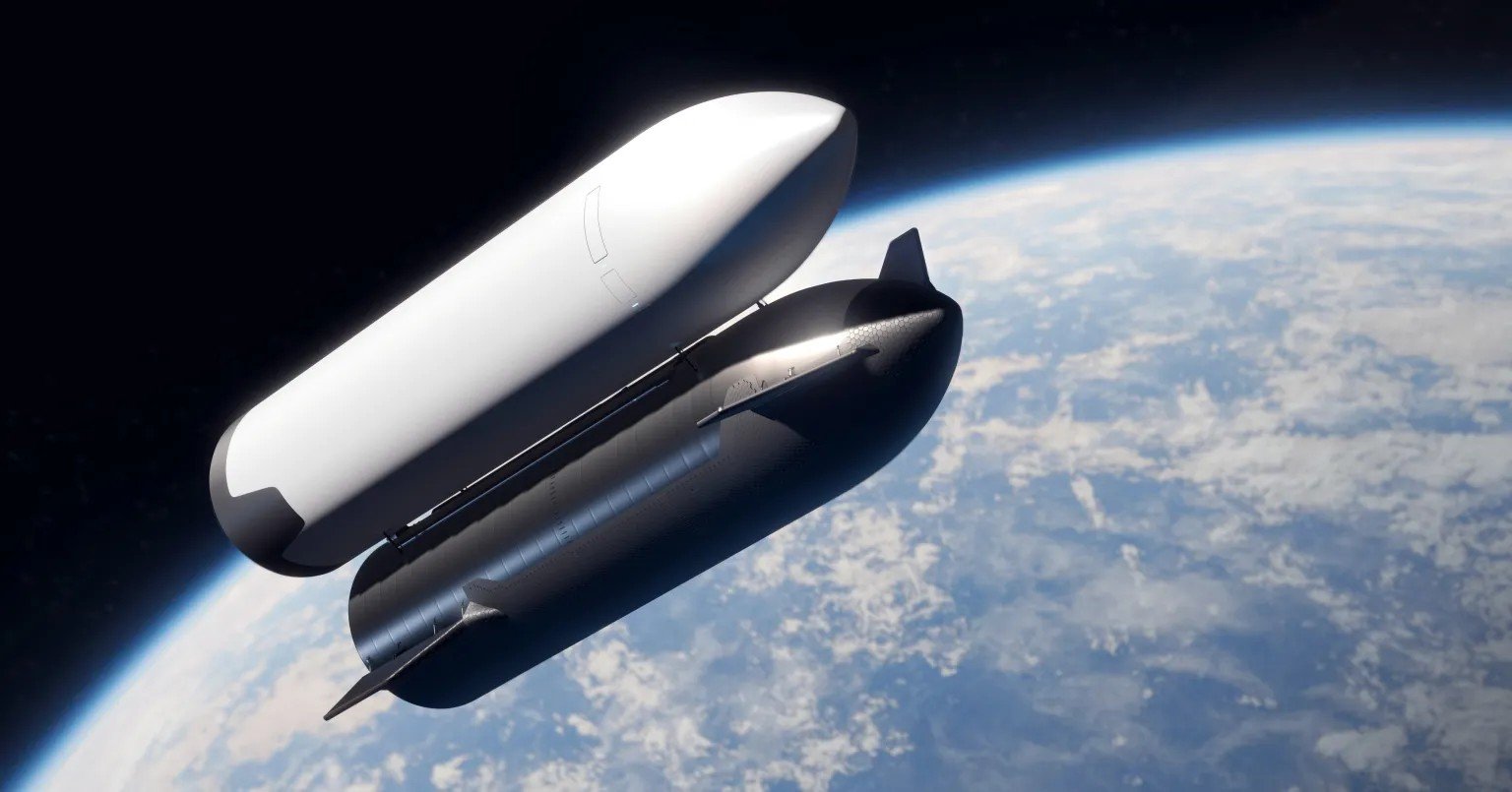 Starship HLS docking with a Starship tanker for in-orbit refueling. Source: SpaceX SpaceX’s new renders clearly show the difference between the company’s standard Starship rocket and HLS. The standard black Starship has a polished stainless steel exterior, while the HLS will be coated in white thermal paint. HLS also won’t feature fins for flight control. Starship HLS docking with a Starship tanker for in-orbit refueling. Source: SpaceX SpaceX’s new renders clearly show the difference between the company’s standard Starship rocket and HLS. The standard black Starship has a polished stainless steel exterior, while the HLS will be coated in white thermal paint. HLS also won’t feature fins for flight control.
This is because HLS won’t return to Earth, meaning SpaceX will do away with the heavy black thermal tiles required for Starship’s reentry in standard models. Instead, HLS will feature special insulating tiles, painted white to reflect solar radiation. SpaceX will also remove flight control surfaces, required for Earth reentry, to reduce weight. This will allow it to carry more fuel, as well as the scientific instruments and machinery required for Artemis III.
Orion to HLS astronaut transfer The in-orbit refuel won’t be the only time Starship HLS will attach to another spacecraft. Once HLS and Orion reach lunar orbit, they will dock together and two of the four Artemis III astronauts will transfer across to Starship. This will occur in a stable lunar orbit called a Near Rectilinear Halo Orbit (NRHO).
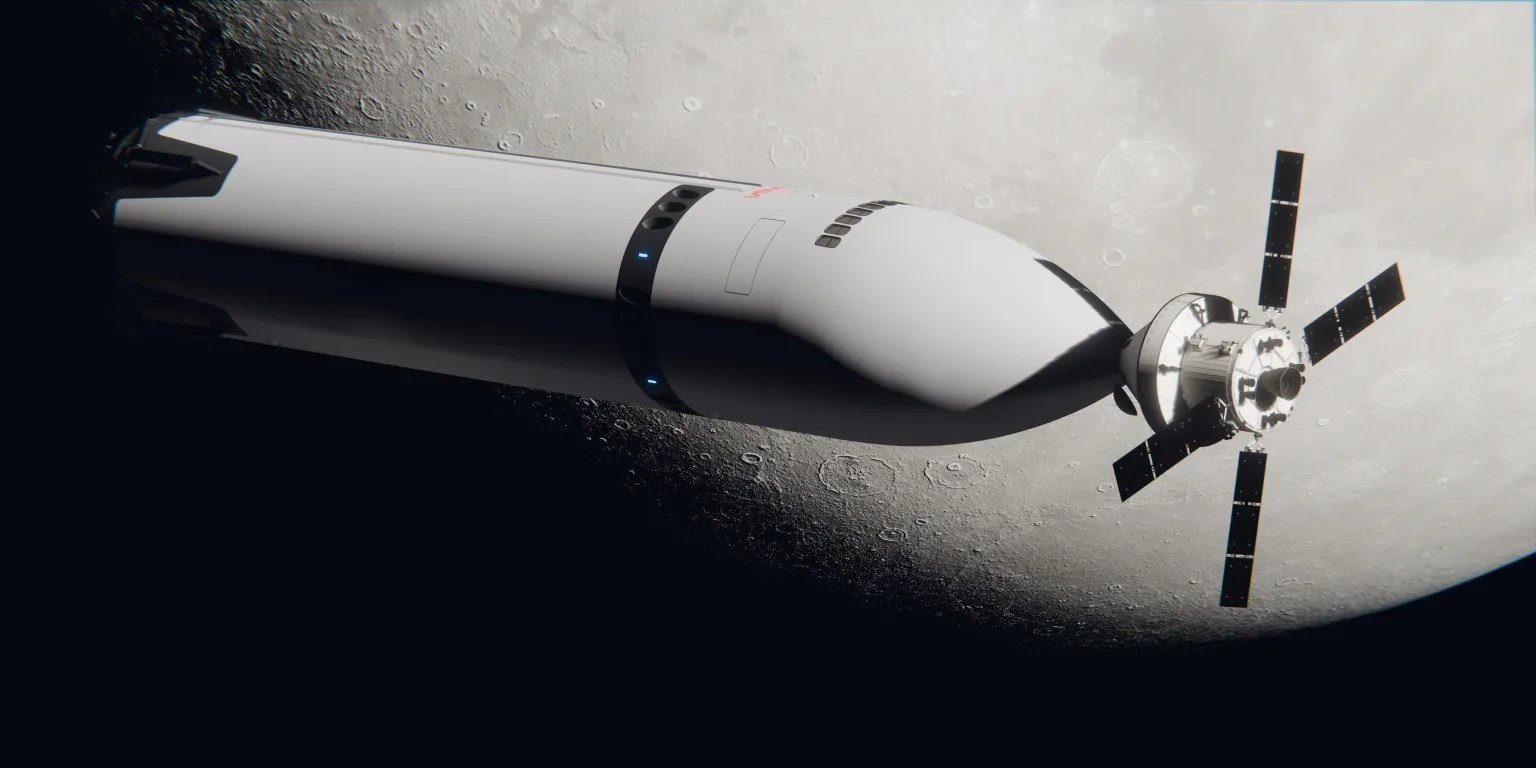 Starship HLS docking with the Orion capsule for astronaut transfer. Source: SpaceX HLS will then undock from Orion, and the lunar lander will begin its descent to the lunar surface. The two remaining astronauts aboard Orion will continue to orbit the moon. The NRHO will take Orion away from the Artemis landing area, and it will not return for six days. Starship HLS docking with the Orion capsule for astronaut transfer. Source: SpaceX HLS will then undock from Orion, and the lunar lander will begin its descent to the lunar surface. The two remaining astronauts aboard Orion will continue to orbit the moon. The NRHO will take Orion away from the Artemis landing area, and it will not return for six days.
HLS landing on the moon In a blog post showing off the new renders, NASA explained that HLS will light up two Raptor engines to perform a braking burn prior to landing on the moon. This burn will reduce the lander’s velocity prior to the historic landing.
Due to the moon’s lower gravity, Starship won’t need to use as much power as it would have to on the Earth. For example, during SpaceX’s recent Super Heavy booster catch, Super Heavy fired up 13 of the booster’s 33 Raptor engines to slow its descent.
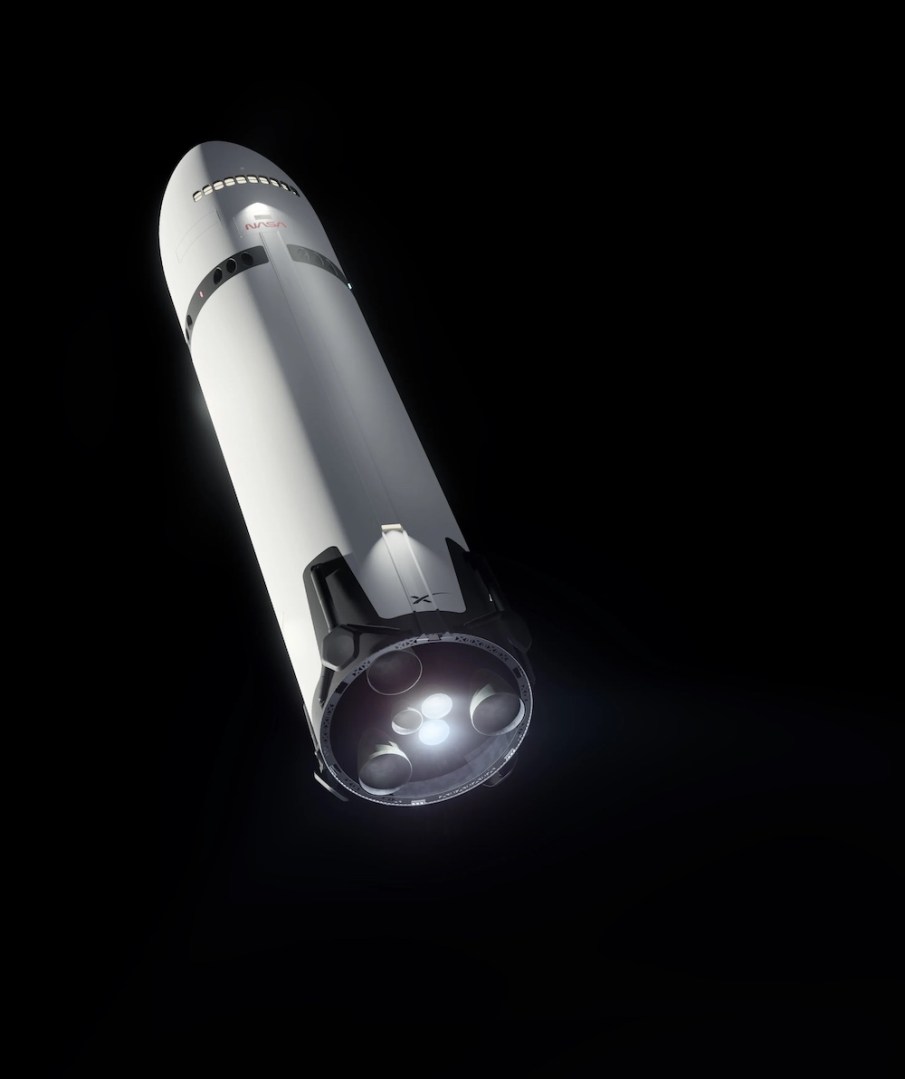 Starship HLS firing two of its Raptor engines as it approaches the lunar surface. Source: SpaceX Similar to the booster recovery test and recent Starship flight tests, SpaceX and NASA will conduct a series of flight tests in preparation for Artemis III. One of the most crucial milestones for SpaceX is an in-orbit refueling test, followed by an uncrewed Starship landing on the moon. Starship HLS firing two of its Raptor engines as it approaches the lunar surface. Source: SpaceX Similar to the booster recovery test and recent Starship flight tests, SpaceX and NASA will conduct a series of flight tests in preparation for Artemis III. One of the most crucial milestones for SpaceX is an in-orbit refueling test, followed by an uncrewed Starship landing on the moon.
“Prior to the crewed Artemis III mission, SpaceX will perform an uncrewed landing demonstration mission on the moon,” NASA explained in its blog post.
The new full HLS render The image below is very similar to a previous render SpaceX released in 2021 when NASA announced it had awarded the company $2.9 billion to fly astronauts to the moon. However, there are a few notable changes. In the previous render, for example, Starship HLS only had four windows, whereas it now has ten.
According to an X thread by Apogee YouTuber Ken Kirtland, the number of engines has also increased from 12 in the initial render to 18 in the current one.
“The engine groups also now have direction to them,” he explained. “This will allow the landing engines to control the vehicle on all axis, without gimbal. Much like RCS thrusters.”
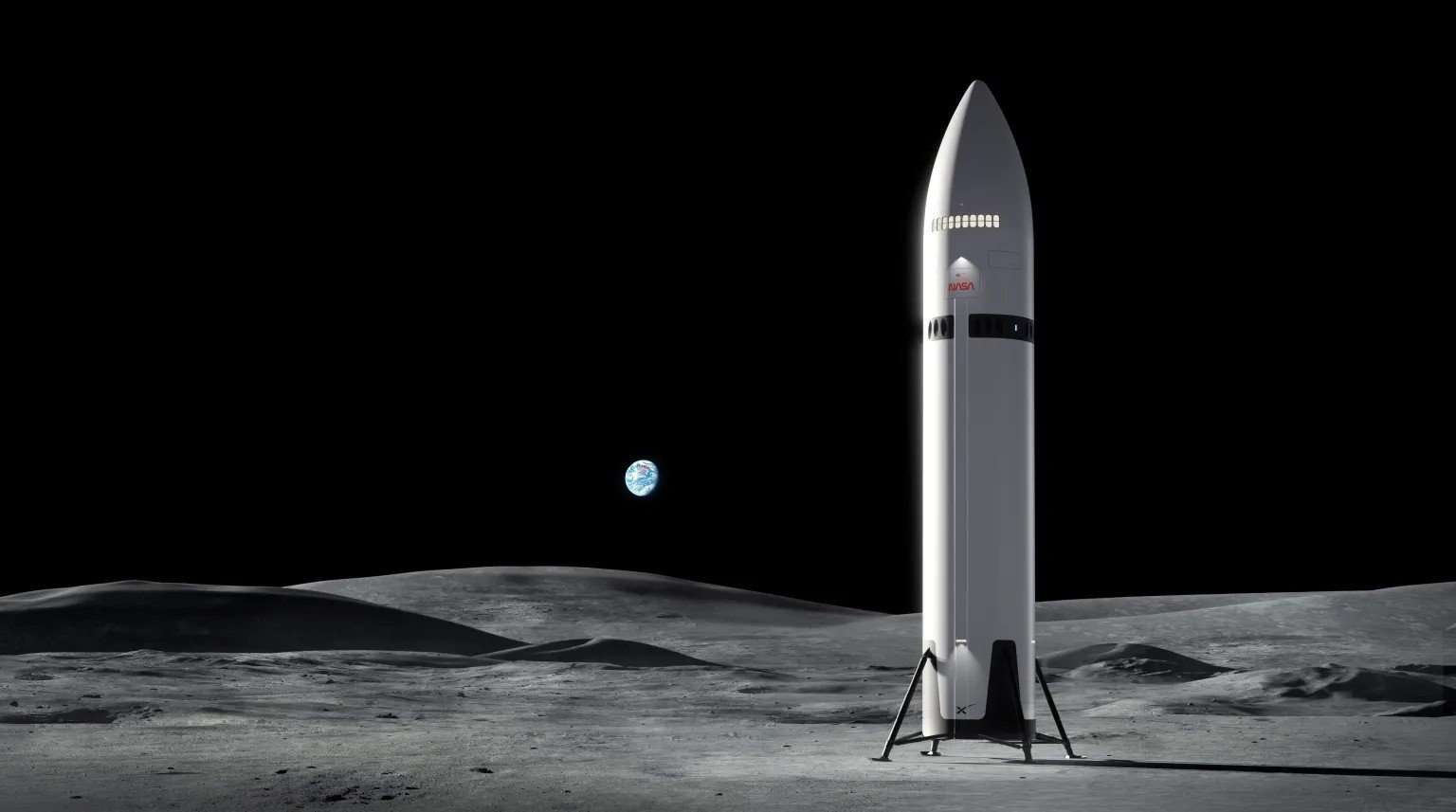 Starship HLS will serve as a lunar base, allowing two of the Artemis III astronauts to spend six days on the moon. Source: SpaceX It is worth stressing that these are only renders, and many of these details are subject to change. In fact, NASA claims there may also be substantial changes to HLS following Artemis III. Starship HLS will serve as a lunar base, allowing two of the Artemis III astronauts to spend six days on the moon. Source: SpaceX It is worth stressing that these are only renders, and many of these details are subject to change. In fact, NASA claims there may also be substantial changes to HLS following Artemis III.
In its blog post, the space agency said it “is also working with SpaceX to further develop the company’s Starship lander to meet an extended set of requirements for Artemis IV. These requirements include landing more mass on the moon and docking with the agency’s Gateway lunar space station for crew transfer.”
The Artemis III lunar base The final render shows the two HLS astronauts in their Axiom Space-designed spacesuits making their way down to the lunar surface in an elevator.
These astronauts will have six days to conduct experiments, gather samples, and explore the lunar south pole, a region never before visited by humans.
Their mission will also mark the longest continuous human presence on the lunar surface, surpassing the current record of 75 hours set during Apollo 17.
Starship is 50 meters tall and it has a diameter of nine meters, making it much larger than the Apollo Lunar Module, providing the Artemis astronauts with spacious living quarters for their extended stay on the moon.
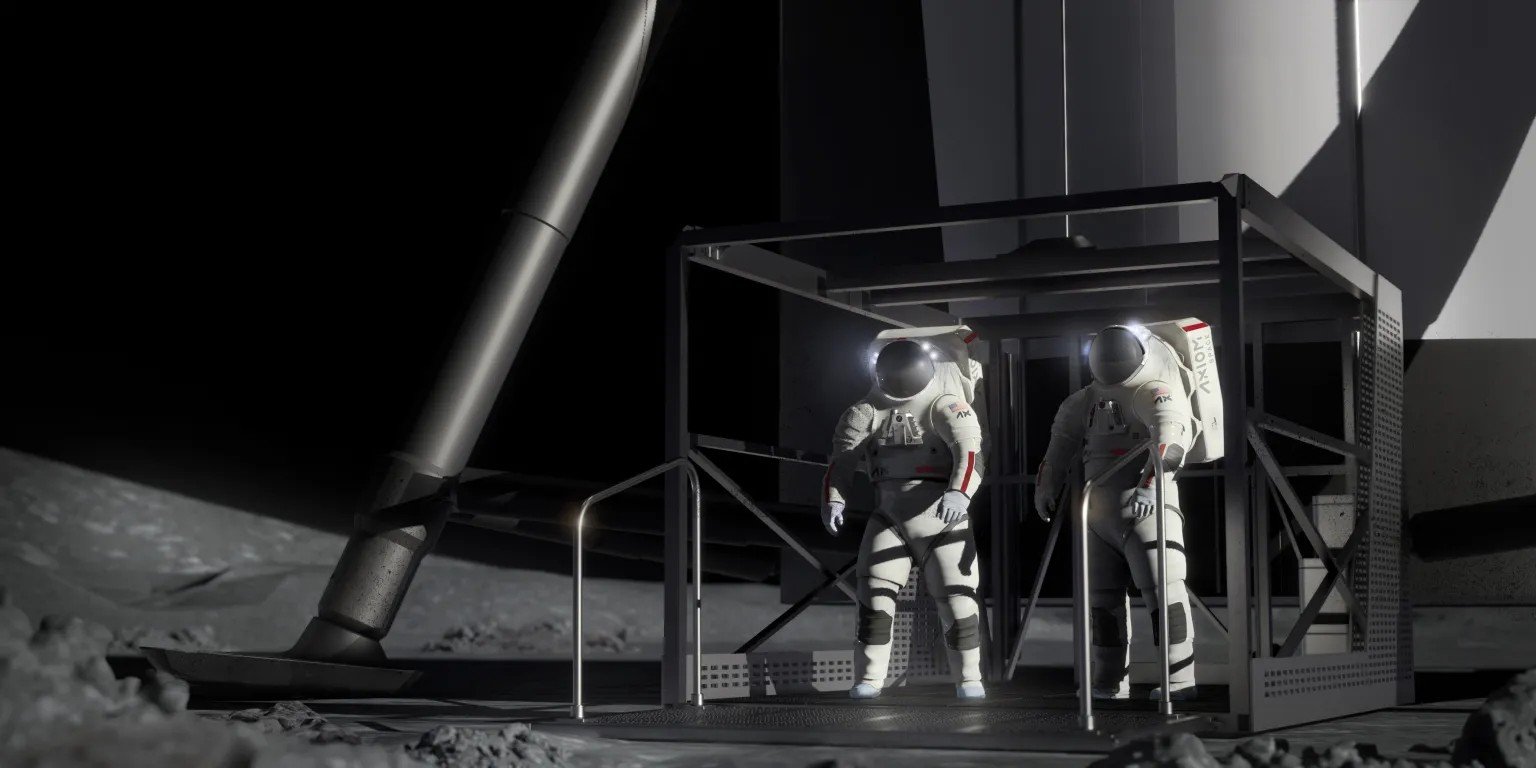 The Artemis III astronauts will wear Axiom Space spacesuits. Source: SpaceX In its blog post, NASA wrote: “With Artemis, NASA will explore more of the moon than ever before, learn how to live and work away from home, and prepare for future human exploration of Mars. NASA’s SLS (Space Launch System) rocket, exploration ground systems, and Orion spacecraft, along with the human landing system, next-generation spacesuits, Gateway lunar space station, and future rovers are NASA’s foundation for deep space exploration.” The Artemis III astronauts will wear Axiom Space spacesuits. Source: SpaceX In its blog post, NASA wrote: “With Artemis, NASA will explore more of the moon than ever before, learn how to live and work away from home, and prepare for future human exploration of Mars. NASA’s SLS (Space Launch System) rocket, exploration ground systems, and Orion spacecraft, along with the human landing system, next-generation spacesuits, Gateway lunar space station, and future rovers are NASA’s foundation for deep space exploration.”
The entire Artemis III mission is expected to last roughly 30 days. Once the two astronauts leave the lunar surface, they will rendezvous with Orion and the two other astronauts. Starship and Orion will dock for five days, allowing ample time for the astronauts to transfer their collected samples and supplies to Orion.
NASA views the Artemis program as the initial step towards establishing a permanent lunar base, which would utilize the abundant water ice believed to exist at the lunar south pole.
This base would not only support sustained lunar exploration but also serve as a stepping stone for further exploration of our solar system, potentially paving the way for human missions to Mars and beyond.
If all goes to plan, Artemis III will allow humans to expand their footprint to Mars and beyond.
ABOUT THE EDITOR Chris Young Chris Young is a journalist, copywriter, blogger and tech geek at heart who’s reported on the likes of the Mobile World Congress, written for Lifehack, The Culture Trip, Flydoscope and some of the world’s biggest tech companies, including NEC and Thales, about robots, satellites and other world-changing innovations. |






 Starship HLS docking with a Starship tanker for in-orbit refueling. Source:
Starship HLS docking with a Starship tanker for in-orbit refueling. Source:  Starship HLS docking with the Orion capsule for astronaut transfer. Source:
Starship HLS docking with the Orion capsule for astronaut transfer. Source:  Starship HLS firing two of its Raptor engines as it approaches the lunar surface. Source:
Starship HLS firing two of its Raptor engines as it approaches the lunar surface. Source:  Starship HLS will serve as a lunar base, allowing two of the Artemis III astronauts to spend six days on the moon. Source:
Starship HLS will serve as a lunar base, allowing two of the Artemis III astronauts to spend six days on the moon. Source:  The Artemis III astronauts will wear Axiom Space spacesuits. Source:
The Artemis III astronauts will wear Axiom Space spacesuits. Source: